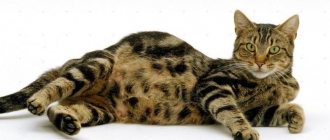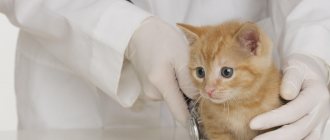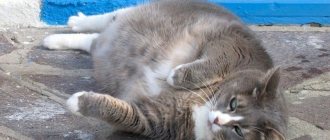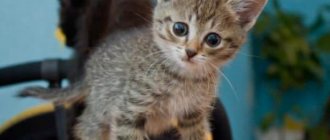There is a misconception that all cats easily bear kittens and give birth without outside help. However, purebred pets often require assistance both during gestation and at the birth stage.
Let's find out how a cat's pregnancy should proceed, what symptoms are a reason to see a doctor, and how a responsible owner should prepare for childbirth.
How long does pregnancy last in cats?
Pregnancy in cats can last from 63 to 67 days. These are average indicators, which are influenced by breed characteristics, number of kittens and other factors. Thus, long-haired breeds usually bear offspring for 10 weeks, and short-haired breeds - 9.
For each breed, the average duration of pregnancy is determined.
| Breed | Duration of gestation, days |
| British Shorthair | 63–69 |
| Scottish lop-eared | 62–69 |
| Bengal | 61–70 |
| Sphinx | 63–66 |
| Maine Coon | 66–68 |
| Oriental cat | 65–66 |
| Somali and Abyssinian | 63–65 |
| Persian | 63–66 |
| Siamese | 59–64 |
The average cat bears kittens for 65–70 days. These values are influenced by the quality of life, the animal’s nutrition, the presence of stress and physical health. Up to three pregnancies are possible per year, but such a frequency of births greatly depletes the body.
For this reason, yard cats cannot boast of their longevity. And it is customary to breed purebreds no more than 3 times every two years.
Important! If the animal does not have breeding value and there are no plans to produce offspring, it is better to carry out sterilization. The optimal age for the procedure is 7–8 months.
Maximum delay in labor
Cats carry kittens for about 2 months. If we take into account the average, a normal pregnancy lasts up to 72 days. If labor has not begun by this time, you should contact a veterinarian. Long term carrying of kittens is dangerous for both newborns and the cat.
Premature birth is no less risky. Kittens born on the 58th day of pregnancy or earlier are considered premature. They are weak and in most cases doomed to death.
Important! If a cat does not have a suitable birthing area, she may abort the contractions and pause labor.
Thai kittens: characteristics of the breed, rules of education
The Thai cat is a short-haired breed that originates in Thailand. Thais are often confused with another Asian cat, the Siamese cat. These breeds have one common ancestor (the traditional Siamese).
It is believed that the Thais are more similar to their ancestors from Thailand, while the Siamese have changed significantly due to selection. Thai cats differ from Siamese in having a denser build and a rounded head (Siamese have a wedge-shaped head).
In accordance with breed standards, the eyes of a Thai cat should be a rich blue, sky-azure color, without a hint of yellowness.
The history of Thai cats begins in Thailand in the 14th century. These animals were kept only in Buddhist temples and royal families. In the 19th century, the Thai ruler gave two kittens to the English general Owen Gould. Thus, the Thai cat came to Europe, and a little later to America.
Preparing cats for pregnancy
Planning pregnancy is the first and important step on the path to getting healthy offspring. First, anthelmintic treatment is carried out, and then comprehensive vaccination against viral diseases (panleukopenia, rhinotracheitis and calcivirus infection).
It is advisable for owners of a purebred animal to check their pet for genetic diseases to which a particular breed is prone. And to be completely sure that both animals are healthy, tests are carried out for coronavirus, immunodeficiency virus, herpes virus and other infections. Otherwise, infection can lead to a pathological course of pregnancy or cause physical abnormalities in kittens.
When does that very moment of mating come?
Experts believe that a cat should reach 1-1.5 years of age. 18 months is the deadline for the first mating. All breeders recommend mating cats after two heats. This is the most suitable period for mating. Males are ready for mating earlier - at 8-10 months (some breeds, for example, Scots at 1.3-1.6 years). Differences in age among males are due to breed. Unlike cats, cats are eager to mate all year round, especially when March comes.
Cats need to select an experienced female for the first mating. Although in practice, even a couple of untied feline representatives will cope with the task. The reproductive instinct in animals is incredibly strong, it is almost a basic need.
After mating, the male needs time to rest and recuperate. You also need to feed your cat nutritious and balanced food. The health of the pet during the mating period must be carefully monitored: be observed by a veterinarian, check for infections and viruses, carry out deworming measures and vaccinations, get rid of ticks and fleas. Prevention measures are also important. The doctor issues a certificate about the pet’s condition; this document will give a guarantee to the female and increase the reputation of the cat’s owner.
Important! Before mating, owners of pedigree animals show documents confirming the origin of the male cat. There are owners who enter into contracts for the mating of animals and the distribution of “profits,” that is, kittens.
During the period of acquaintance with the “groom” and mating, the cat must be in heat, otherwise there will be no mating. If possible, both cats' claws are trimmed to prevent injury.
Nuances and possible complications
During pregnancy, cats can experience complications that can be caused by infections, genetic diseases, and even external factors. The life and health of your pet will depend on timely detection of the problem and contacting a doctor.
False pregnancy
If the mating was not successful, or the embryos did not attach to the uterus, a false pregnancy may occur. In this condition, the cat appears all the signs of pregnancy: reddening of the nipples, increased appetite and body weight, drowsiness and search for a secluded place. But at the appointed time there will be no labor activity, as well as fetal movement.
It is impossible to independently determine whether a cat is pregnant or a false pregnancy has occurred. This is the task of a veterinarian. Only an ultrasound of the abdominal cavity or its palpation can clarify the situation.
Most often, false pregnancy is provoked by the following factors:
- overweight cat;
- mating with a castrated or too young cat;
- hereditary predisposition (the Oriental breed, Cornish Rex and Sphynx are prone to it);
- close proximity to pregnant cats;
- severe stressful situations.
False pregnancy is dangerous if it is characterized by a long course or occurs several matings in a row. The condition leads to depletion of the body and can provoke mastitis, pyometra and other dangerous diseases.
Preventive measures will help prevent its occurrence:
- proper and balanced diet;
- calm atmosphere in the house;
- early diagnosis by a veterinarian;
- mating with a healthy, proven cat.
To stop this pathological process, the doctor may prescribe sedatives, as well as drugs to stop the production of cat milk.
Frozen pregnancy
Sometimes a cat may experience a frozen pregnancy. Stopping embryo development occurs for a number of reasons:
- unsuccessful previous pregnancies;
- hormonal imbalances;
- some infectious diseases;
- pathologies of uterine development.
Such changes lead to the death of one or more embryos. Consulting a veterinarian will allow you to assess the situation and prevent dangerous consequences. After all, if left in the womb for a long time, a frozen fetus can begin to rot, infect healthy fruits and harm the cat itself.
In this situation, the doctor will help you make the right decision: wait for a natural birth so that the embryo comes out with healthy kittens, or begin to immediately stimulate labor. If all the embryos freeze, a miscarriage occurs.
Important! Ultrasound examination will allow you to determine if a cat is pregnant or find out about the pathology of the fetus. This procedure also determines the kittens' heartbeat and their rate of development.
Superfetation
An unusual phenomenon in cats is parallel pregnancy or superfetation. This term implies the conception and gestation of two broods at different stages of maturation. The process is observed if the cat is bred again when she is already pregnant. In this case, embryos develop in the uterus with a significant difference in time. The gestational age usually does not increase.
Superfetation most often ends in the death of late fruits. When labor occurs, they are pushed out. It is much less common for cats to give birth twice when the remaining kittens are successfully carried to term. When diagnosing a parallel pregnancy, it is recommended that the birth be carried out under the supervision of a veterinarian. This can increase the chances of survival of the younger litter.
What are the dangers of early pregnancy in cats?
The first heat indicates the cat's readiness to become pregnant. This process is individual for each cat and can occur from 6 to 11 months. However, its appearance is not a reason to plan a mating.
Experts tend to believe that it is better to introduce a cat for the first time no earlier than a year. By this time, the animal’s body will be fully strengthened and will be able to bear healthy offspring. And in teenage cats, pathologies of fetal development are often observed.
Symptoms of the onset of labor
Early warning signs of childbirth are sagging of the abdomen as a result of relaxation of the ligaments, as well as retraction of the sacral region.
On the eve of delivery, swelling of the genital organs and mammary glands occurs, and droplets of colostrum are released. Viscous mucus without pathological impurities comes out of the loop.
Read the article about bleeding in a pregnant cat.
When labor occurs, the water breaks, releasing a grayish-pink fluid. Then contractions appear, which normally last for an hour, which, if the outcome is favorable, end with the birth of offspring.
Features of the first pregnancy
During the first pregnancy, special care, feeding and maintenance of the cat are required. There are certain recommendations for this period:
- With natural nutrition, a complex of vitamin and mineral supplements is introduced into the diet.
- When feeding dry food, preference is given to the line for kittens or pregnant cats.
- By the 6th week of pregnancy, the frequency of feedings increases. In total, 4–5 appointments are carried out per day.
- Regularly weighing your pet will help prevent overfeeding. But it can lead to a difficult birth.
Another case is when during coitus the female falls over on her side
The owner will have to hold the animal in a suitable position (there are situations when cats are able to solve this problem without outside intervention).
The female is not given - a difficult situation, since the lady decides with whom she will have sexual intercourse. I have to take her home. As a last resort, you can use a probe inserted into the vagina. With its help, ovulation is provoked, and the cat will surrender into the clutches of an unloved man. Also, some breeders lock up two purrs of different sexes and believe in contact between them.
A situation where a female suddenly stops estrus with all the accompanying signs. This happens due to stress. We must wait until the cat gets used to it and gets used to it, everything will be restored. Probably, the female should be left to stay with the cat owners so that the animals can get used to it and make friends.
Cat pregnancy calendar by week
On average, a domestic cat gives birth 61–67 days after mating. The minimum period is 56 days, the maximum is 72 days. You can understand that a cat is pregnant after the third week. To do this, you should know what signs are inherent in each stage of fruit development.
1–3 week
Pregnancy in cats at this stage can only be determined using ultrasound. The study will also show how much fruit she bears. External signs appear towards the end of this period.
4–6 weeks
At the beginning of the fourth week, redness and swelling of the nipples will occur, and vomiting may occur. These are the main signs of pregnancy in a cat. From week 5, appetite increases. Animals become more affectionate and more demanding of attention from their owners. By week 6, the belly increases slightly.
7–9 weeks
From the 7th week, fetal movement can be felt. This sign is especially noticeable in short-haired breeds. The kittens in the belly begin to grow quickly, which affects its size. Now pregnancy is noticeable even to the naked eye. With the onset of the 9th week, it is recommended to prepare a secluded place for the pet to give birth and wait for the symptoms of its approach.
How to prepare a place for offspring?
During childbirth, the animal feels calmer in a quiet, secluded place, so you need to prepare a bed or box in advance. The peace of the last two weeks depends on the behavior of all household members. Young children especially should not fuss while waiting for a kitten, this will make the cat nervous.
Over time, you need to accustom the animal to a new resting place. But it also happens that for some reason the cat does not like the bed, then you just need to track where the animal tries to hide during childbirth.
Order pet products in Krasnoyarsk from the Pharmacia online pharmacy. Ordering products through online search is available with a discount of up to 10%.
Caring for a pregnant cat
During pregnancy, a cat's body is exposed to great stress. During this period, the animal especially needs proper nutrition, care and attention.
Features of feeding
If your pet's diet consists of industrial food, then for the period of gestation of kittens it is recommended to choose brands of at least super-premium class. Growing embryos and the mother's body need food rich in vitamins and minerals. These requirements are met by lines for kittens, pregnant and lactating cats.
With natural nutrition, the diet includes:
- boiled veal;
- meat broth;
- boiled sea fish;
- buckwheat, oatmeal and rice porridge;
- fruits and vegetables;
- boiled cartilage;
- chicken eggs;
- sour cream, cream, yogurt and other dairy products.
The cat is fed up to 5 times a day. And from the second month, the daily norm increases by 1.5–2 times. Despite the fact that the diet will consist of the right foods, this is not enough for the expectant mother and her offspring. Therefore, during pregnancy, a complex of vitamin and mineral supplements is additionally introduced.
Is it possible to get vaccinated?
The protection period of complex vaccines lasts up to a year. If you are about to breed a cat that has completed this period, or has no vaccination at all, you need to take care of it in advance. Vaccination is allowed one month before the expected date of mating.
Important! Administration of the vaccine to a pregnant cat can lead to miscarriage or pathologies in newborn kittens.
Is it possible to give medications?
The question of whether it is possible to give a pregnant cat medications and which ones should be decided by a veterinarian. Even if the instructions for the drug allow its use, the final word remains with the specialist. A specific decision is made based on practical experience and an assessment of the pet’s condition.
If you have doubts about the correctness of the prescribed medication, you can always consult another veterinarian and draw the right conclusion based on several opinions.
Is it possible to pick up a cat?
Pregnant cats walk for two months, and throughout this period they need affection and attention from their owners. It is simply necessary to pick up your pet, but you need to do it carefully. Squeezing the stomach, causing discomfort to the animal, or throwing it is strictly prohibited.
Description of the breed
The modern Thai cat has a muscular body of medium size, blue eyes, and short and silky hair. The tail and ears are medium in size. The color can be different: brown, black, red, gray, spots and stripes on the coat are allowed.
The Thai cat is distinguished by its lively character and friendliness. She is extremely curious and sociable. When the owner is at home, the cat follows him everywhere and participates in all activities. The Thai woman loves to “talk”; she notifies the person immediately about dissatisfaction or her desires.
An extraordinary mind pushes a cat to seek adventure. She is interested in literally everything, every closed door causes her a storm of indignation. The Thai cat will not calm down until it explores all the rooms in the house. Kisa even manages to open dresser drawers. Such activity is not always liked by owners who have to eliminate the consequences of their pet’s pranks.
Preparing for childbirth
Responsible owners begin to prepare the cat even before mating. This applies to a balanced diet, medical examination, deworming and vaccination.
Healthy activity of the pet is the key to a favorable pregnancy. But in recent weeks it is worth protecting her from jumping on tables, cabinets and other high objects. If the landing is unsuccessful, the cat may hit its stomach and harm the kittens.
If the pet is giving birth for the first time, it is better for the owners to make an agreement with the veterinary clinic in advance. This is necessary to receive round-the-clock counseling and emergency medical assistance if necessary.
Place for birth
The cat gives birth in two months, and a week before the upcoming event she is in search of a secluded place. A good option is an exhibition tent or a special maternity complex. If there are none, a spacious bed, a drawer, or even a large box will do.
The main conditions are sterile cleanliness, absence of drafts, warmth and a calm atmosphere.
The preparation of the site must be taken responsibly. Otherwise, when the due date approaches, the cat will rush restlessly around the house. And after the end of labor, dragging the kittens is possible.
Postpartum period
The absence of contractions for 2 hours and the prolapse of the abdomen indicates the completion of the birth process. The behavior of the female also changes: she calms down, her breathing evens out, she lies down more comfortably in the box, and continues to lick and feed the babies. You should not give food to a woman in labor immediately after birth, but you can offer water or milk. She usually drinks only when the process is over.
You need to carefully replace the diapers with clean ones and place a tray nearby so that the mother does not move away from the kittens for a long time. But it is not recommended to pick them up; the cat may lose interest in them or react aggressively to this. It's better to leave her alone for a while.
Purchasing a kitten
It is best to adopt a kitten at 3-4 months: at this age, adaptation to a new home and separation from its mother will occur painlessly. When choosing, it is important to pay attention to the pet’s behavior. It is believed that the animal's high activity and playfulness indicate its good health.
What to pay attention to:
- absence of “whistle” when the animal breathes;
- smooth and clean fur (there should be no wounds or ulcers on the body);
- absence of black spots on the ears, mucus in the corners of the eyes and nose;
- availability of a veterinary passport in which vaccinations will be recorded.
At 12-16 weeks, the kitten should already be accustomed to the tray and scratching post.
Interesting Facts
During the existence of the breed, many interesting things have been associated with the Thai cat:
- At the first exhibitions in Moscow and Leningrad they were exhibited under the name “Old Siamese” in the “Beginners” category.
- Thai kittens are born with snow-white fur. Dark markings begin to appear towards the end of the first month of life.
- In the Middle Ages, exporting Thai cats from Siam was punishable by death.
- Representatives of the breed were used to breed Burmese and Balinese.
- The 1991 Thai Cat Standard is currently under revision. Therefore, only those individuals whose registration documents contain the signatures of two experts are allowed for breeding.











